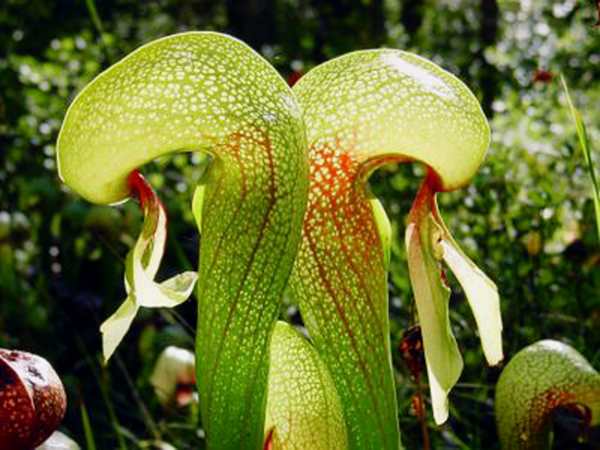Cryptozoology and cryptobotany are fields brimming with tales of strange and unusual plants and animals. While the public is familiar with cryptids like the Loch Ness Monster and Sasquatch, few have heard of the Man-Eating Trees of Madagascar or the Mongolian Death Worm. These lesser-known legends offer a glimpse into the world’s most bizarre and captivating natural mysteries.
The Man-Eating Trees of Madagascar
In 1881, the South Australian Register published a story by traveler Carle Liche, who claimed to have witnessed the native Mdoko tribe in Madagascar sacrificing a woman to a man-eating tree. According to Liche, the tree’s tendrils strangled the woman and engulfed her body. This tale was later recounted in the 1924 book “Madagascar, Land of the Man-Eating Tree” by former Michigan Governor Chase Osborn. Osborn mentioned that missionaries and locals in Madagascar were familiar with the deadly tree.
However, skepticism surrounds Liche’s story. Neither the Mdoko tribe nor the man-eating tree has ever been found, suggesting the account may have been exaggerated for dramatic effect. Despite this, the legend persists, intriguing those fascinated by the unknown.
The Mongolian Death Worm: A Deadly Enigma
From the steppes of Mongolia comes the tale of the Mongolian Death Worm, a creature with a particularly grotesque appearance. Described as resembling a bright red, bloody cow intestine, this worm is said to be about four feet long. It allegedly spits a deadly yellow substance and can kill with electricity, similar to an electric eel.
Expeditions to find the Mongolian Death Worm have been unsuccessful, yet the story is widespread. This persistent legend hints at the possibility of undiscovered creatures lurking in remote regions. Given the discovery of new species in places like the jungles of Vietnam, it’s not far-fetched to imagine that a creature like the Death Worm could exist in the desolate Gobi Desert.
South America’s Giant Minhocao
South America offers its own cryptic marvels, including tales of the enormous Minhocao. This giant worm-like creature is reported to inhabit the forests and reach lengths of up to 75 feet. Historical accounts describe it as a tunnel-digging worm with appendages on its head, akin to a snail or slug. However, no sightings have been reported in over a century, leading to speculation that the Minhocao may have gone extinct or never existed at all.
Carnivorous Plants: Nature’s Meat-Eaters
Cryptids aren’t the only mysterious entities in the natural world. Carnivorous plants, known for their ability to trap and consume animals, present a fascinating example of nature’s ingenuity. Charles Darwin devoted fifteen years to studying these plants, which solve the problem of nutrient-poor soil by deriving essential minerals from their prey.
Pitcher Plants
Pitcher plants lure insects into vase-like leaves filled with digestive chemicals. The sweet-smelling nectar on the plant’s hood attracts insects, which then slide down the slippery interior to their doom. Some pitcher plants, like the yellow trumpet, even paralyze their prey with a narcotic nectar.
Sundews
Sundews use sticky hairs to ensnare insects. When an insect lands on a sundew leaf, it becomes trapped by the sticky secretion. As the insect struggles, more hairs attach, eventually suffocating the prey. Digestive juices then dissolve the insect’s body, allowing the plant to absorb the nutrients.
Venus Flytrap
The Venus flytrap, native to North and South Carolina, features leaves that snap shut when an insect triggers sensitive hairs inside. The interlocking “teeth” prevent escape, and digestive glands on the inner surfaces of the leaf break down the prey. Despite its fearsome reputation, the Venus flytrap poses no threat to humans.
Man-Eating Plants: Myth or Reality?
While no known carnivorous plant is large enough to consume a human, legends of man-eating flora persist. One possible source of these stories is the Amorphophallus titanum, or “corpse flower.” This plant, native to Indonesia, can grow over nine feet tall and emits a foul odor reminiscent of rotting flesh to attract pollinators. Although it looks and smells like it could devour a person, the corpse flower is not carnivorous.
Environmental Threats to Carnivorous Plants
Ironically, humans pose a greater threat to carnivorous plants than the plants do to us. Wetland destruction and commercial plant collection endanger species like the pitcher plant and Venus flytrap. Conservation efforts are crucial to preserving these fascinating and ecologically significant plants.
Conclusion
The fields of cryptozoology and cryptobotany continue to captivate with their tales of enigmatic creatures and extraordinary plants. Whether it’s the chilling account of Madagascar’s man-eating tree, the grotesque legend of the Mongolian Death Worm, or the ecological wonder of carnivorous plants, these stories remind us of the boundless mysteries still hidden in our world. As we explore and seek to understand these phenomena, we uncover the beauty and complexity of nature, inspiring both awe and respect for the natural world.

